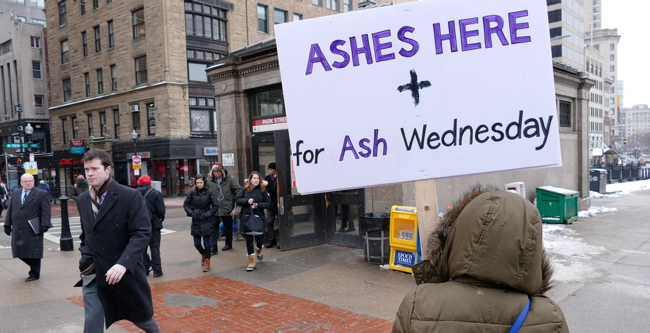
Congregations across the nation are taking to the streets, offering ashes on-the-go to busy Christians. Photo by the Roman Catholic Archdiocese of Boston, courtesy of Flickr
WEDNESDAY, MARCH 6: The pancakes, paczkis, blintzes all have been eaten—and today, the solemn Lenten season begins for Western Christians. It’s Ash Wednesday.
Starting today, Christians observe the 40 days of Lent (excluding Sundays) in preparation for Easter. Western Christians (Roman Catholics, Protestants and others in the “Western” branches of the church) are called to repent and reflect. Many “give up something” for Lent. But the Western tradition is not nearly as extreme as the dietary rules followed by Eastern Christians, who begin their Fast of Great Lent on Monday March 11 this year—an observance known as Clean Monday.
Did you know? The Catholic Church permits ashes on the forehead for anyone who wishes to receive them—not just baptized Catholics. Many Protestant and Anglican churches also include this rite at the start of Lent and more congregations add the service each year.
In fact, Lent is more popular than ever nationwide in the U.S.
In his book Our Lent: The Things We Carry, ReadTheSpirit magazine Editor David Crumm writes: “Observance of Lent is booming across the U.S., including nontraditional groups and evangelical churches. Even Catholic parishes nationwide are seeing a rise in season-long observances. This makes sense in an era of turbulent change in our world. A return to spiritual practices—from praying daily to following the centuries-old traditions of Lent—is a journey that reconnects us with the timeless wisdom of our faith.”
Where do we see signs of the vitality of the Lenten season in 2019? First, we see it in ongoing survey research about the religious practices of ordinary Americans. Then, we already are seeing it in news headlines.
One example: The evangelical social-action movement Sojourners is urging followers to take Ash Wednesday and the Lenten season seriously this year. Sojourners’ Jim Wallis has published an open letter about this effort on the group’s website.
And—from the spiritual to the strictly commercial realm—Ad Age magazine just reported that the Gorton’s seafood company is preparing a clever new version of its TV ad campaign featuring male mermaids—Mer-Bros. Ad Age reports, “The updated ads come as Gorton’s and other seafood brands gear up for Lent, a busy time for the brand because people often eat more seafood while abstaining from eating meat on Ash Wednesday and on Fridays.”
This is a very serious matter in America’s multi-billion-dollar fast-food industry, as well. Readers Digest magazine recently published a lengthy story about the history of McDonald’s Filet-O-Fish sandwich, which was created many years ago to meet the preferences of Catholic customers. And today? The magazine reports that about a quarter of the annual Filet-O-Fish sales are during the 40 days of Lent.
A 40-Day Companion for Lent
Many of our readers, over the years, have told us they enjoy reading Crumm’s book during Lent—a book that combines both inspirational reflections on Bible readings as well as a sometimes light-hearted look at contemporary life, today. The book is widely available via online bookstores. Here is the Amazon link for paperback and Kindle.
What’s the book about?
Our Lent is a 40-day, 40-chapter invitation to enjoy that combination of faith and self-guided reflection. Each daily chapter explores something Jesus showed us, including: coins, basins, bowls, bread, cups, swords and tables. In each chapter, the author shares a biblical story from Jesus’ final journey to Jerusalem and explains the significance of the tangible things Jesus lifted up for his followers. Then, each chapter connects the Bible lesson with our own daily lives as well as the lives of men and women who are celebrated in our culture, including the spiritual writer Thomas Merton, the actress and singer Judy Garland, the country musician Merle Haggard and even the beloved Cat in the Hat. After 40 days of connecting scripture with modern life, readers will find themselves freshly aware of the many blessings we have received and the challenges we face in helping to heal the world around us.
